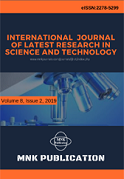DOI:10.29111/ijlrst ISRA Impact Factor:3.35, Peer-reviewed, Open-access Journal
Research Paper Open Access
International Journal of Latest Research in Science and Technology Vol.3 Issue 5, pp 75-83,Year 2014
Correspondence should be addressed to :
Received : 23 October 2014; Accepted : 27 October 2014 ; Published : 31 October 2014

| Download | 125 |
|---|---|
| View | 180 |
| Article No. | 10398 |
This study focused on the the competitiveness of small and medium agribusiness firms in East Java and specifically refers to the sources of competitiveness, scale advantages, handicaps imposed on small firms by their size, avoiding the disadvantages of small size, constraints on growth, sources of crises, and the resurgence of small firms. This study can be classified as applied and explanatory research. This study was conducted using both primary and secondary data. In collecting primary data, observations and interviews were the main techniques. A questionnaire was sent to the managers and top managers of 41 agribusiness firms in East Java. Information was obtained from 30 firms. The results indicate that The small and medium enterprises are less vertically integrated than large firms. One obvious explanation for this difference is that large firms are more likely to be able to fully utilize an optimum size, or at least a larger-scale facility for performing a process or providing a service which could be bought out. Three sources of competitiveness stood out: ‘the channels of distribution used’, ‘product development’ and ‘the quality of the services provided for customers’. The fourth most important source of competitiveness was efficiency of production, and this was closely followed by marketing expertise.
Copyright © 2014 Y. Lilik Rudianto et al. This is an open access article distributed under the Creative Commons Attribution 4.0 International (CC BY 4.0) license which permits unrestricted use, distribution, and reproduction in any medium, provided the original work is properly cited.
Y. Lilik Rudianto , " The Competitiveness Of Small And Medium Agribusiness Firms In East Java Indonesia ", International Journal of Latest Research in Science and Technology . Vol. 3, Issue 5, pp 75-83 , 2014

MNK Publication was founded in 2012 to upholder revolutionary ideas that would advance the research and practice of business and management. Today, we comply with to advance fresh thinking in latest scientific fields where we think we can make a real difference and growth now also including medical and social care, education,management and engineering.

We offers several opportunities for partnership and tie-up with individual, corporate and organizational level. We are working on the open access platform. Editors, authors, readers, librarians and conference organizer can work together. We are giving open opportunities to all. Our team is always willing to work and collaborate to promote open access publication.

Our Journals provide one of the strongest International open access platform for research communities. Our conference proceeding services provide conference organizers a privileged platform for publishing extended conference papers as journal publications. It is deliberated to disseminate scientific research and to establish long term International collaborations and partnerships with academic communities and conference organizers.